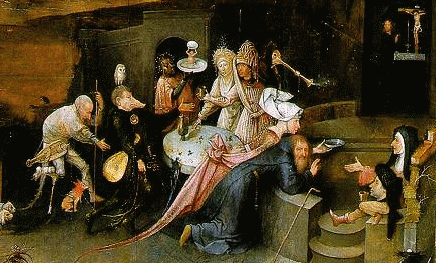
Hieronymus Bosch c.1450 - 1516
``The master of the monstrous... the discoverer of the unconscious.''
-- Carl Gustav Jung, on Hieronymus Bosch
Biography
Hieronymus, or Jerome, Bosch, b. c.1450, d. August 1516, spent his entire artistic career in the small Dutch town of Hertogenbosch, from which he derived his name.
At the time of his death, Bosch was internationally celebrated as an eccentric painter of religious visions who dealt in particular with the torments of hell. During his lifetime Bosch's works were in the inventories of noble families of the Netherlands, Austria, and Spain, and they were imitated in a number of paintings and prints throughout the 16th century, especially in the works of Pieter Bruegel the Elder.
Bosch was a member of the religious Brotherhood of Our Lady, for whom he painted several altarpieces for the Cathedral of Saint John's, Hertogenbosch, all of which are now lost. The artist probably never went far from home, although records exist of a commission in 1504 from Philip the Handsome (later king of Castile), for a lost Last Judgment altarpiece. None of Bosch's pictures are dated, although the artist signed many of them.

Bosch, Hieronymus: The Temptation of St Anthony c. 1500; Oil on panel, tryptych describing the ordeals of St Anthony; Museu Nacional de Arte Antiga, Lisbon
Bosch's spiritual heroes were the saints who endured both physical and mental torment, yet remained steadfast. Among the saints, Bosch's favorite was Saint Anthony, the subject of his triptych The Temptation of Saint Anthony (c.1500; Museo National de Arte Antiga, Lisbon), which features physical punishment on the left wing, a Black Mass in the center, and the blandishments of food and sex on the right wing. St. Anthony's triumph over such trials is mirrored by those of other hermit saints and by the Passion of Christ, whose arrest and carrying of the cross adorn the exterior of the Lisbon altarpiece.
Bosch was preoccupied with themes of torment and the sinfulness of man, which replaced earlier, more optimistic visions of Christ and the Virgin with feelings of anxiety, fear, and guilt. His sources for such unusual images were the dark corners of the medieval imagination, the gargoyles and monsters of cathedral decoration, and the marginal illustrations of books and popular prints.
In Bosch's day, temptation not only had the meaning it has today, but also meant physical/mental assault by demons. So St Anthony is not only tempted by the pleasures of the flesh and so on, he is also beaten up and terrorized by the demons.